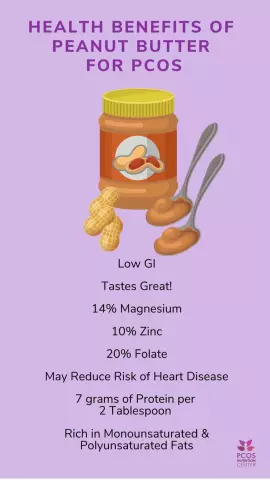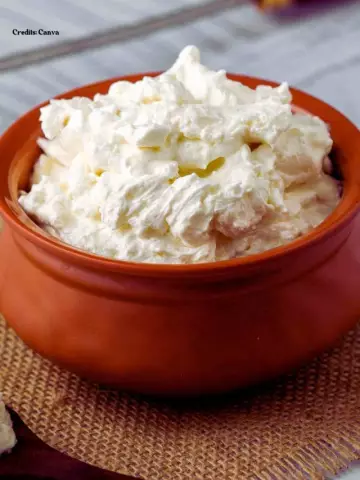- Author Rachel Wainwright [email protected].
- Public 2023-12-15 07:39.
- Last modified 2025-11-02 20:14.
Peanut paste
Peanut butter is a high-calorie and highly nutritious product that is very popular in America. With a vegetarian lifestyle, it is a worthy alternative to meat.
Description

Peanut butter is made from toasted peanuts - peanuts from the legume family. The cultural birthplace of peanuts is South America. It is reliably known that pasta was invented in 1890 by an American dietitian who was looking for an alternative diet for vegetarians. It turned out that peanuts are rich in proteins and vitamins necessary for the body. Soon the product gained such popularity that it began to be mass-produced.
Then the technology of making peanut butter was different from the modern one: the nuts were ground after boiling, which led to the loss of the characteristic flavor of the paste. After receiving the first patent for the production of pasta, special crushers for grinding peanuts appeared on the market, which made it possible to make pasta at home.
K. Sumner, a large trader who owns large trading floors in St. Louis, was engaged in the massive promotion of pasta to the market. He presented the product at the 1904 National Universal Exhibition. By 1922, the pasta production technology had changed somewhat, its shelf life increased to one year. This led to its spread outside California. Soon, several more subspecies of this product appeared, including the popular "crispy" pasta to this day, to which sugar and finely chopped peanut pieces are added after cooking, and the classic creamy pasta.
Today, the United States is the main exporter of peanut butter, and it takes half of the country's entire crop to make it. Only Chile and Argentina can compete with America in the production of peanut butter.
Different types of peanut butter can be made depending on the duration of the grinding process. Classic paste is a mixture of peeled ground nuts, a small amount of salt and sugar, vegetable oil and all kinds of additives that ensure consistency stability. Now on the shelves you can see pastes with the addition of candied fruits, coconut, chopped nuts, cream pastes, pastes without sugar or salt, etc.
According to statistics, about 40 million people consume peanut butter in America every day. A high-quality paste should have a uniform creamy consistency, with a characteristic aroma and taste of freshly roasted peanuts. Its color can range from light brown to brown. Depending on the manufacturing technology, its shelf life is from six months to a year at storage temperatures up to 20 degrees Celsius.
Traditionally, peanut butter is spread on bread or toast and consumed for breakfast along with milk, coffee or tea. Peanut butter and jelly sandwiches are popular in America. In cooking, it is used to make muffins and confectionery, and is also added to sauces and risottos to give them a nutty flavor.
The composition and benefits of peanut butter
In terms of their nutritional value, peanuts are not inferior to such legumes as beans and peas. It contains a lot of vegetable protein completely devoid of cholesterol, as well as vitamins PP, A, B1, B2, E. Peanuts contain folic acid, which promotes cell renewal and growth, fiber, macro- and microelements (zinc, iron, iodine, phosphorus, calcium, cobalt, potassium). It also contains antioxidants - substances that protect body cells from the adverse effects of free radicals. This is what makes peanuts one of the most effective drugs in the prevention of cardiovascular diseases. According to this indicator, he is on a par with blackberries and strawberries, yielding, perhaps, to the undisputed leader - the pomegranate. According to recent research,regular consumption of peanut butter (within reasonable limits) reduces the risk of cardiovascular diseases by 15-20%.

The product undergoes cold processing during the manufacturing process, so that the benefits of peanut butter are the same as those of peanuts. In it, just like in the nut itself, all vitamins, fiber, macro- and microelements that are necessary for the full functioning of the body: heart, liver, nervous system and other organs are preserved.
The benefits of peanut butter are also believed to increase testosterone, which helps burn fat and build muscle. The high amount of protein is an alternative to meat for a vegetarian lifestyle.
Among the stars of fashion and show business, the peanut diet is popular, which increases the feeling of fullness.
The harm of peanut butter
The first harm of peanut butter is its allergenicity. If a person suffers from allergies to certain types of nuts, then the paste must be used with great care.
The second harm of peanut butter is its high calorie content and fat content, so it is not recommended to consume more than 3-4 tablespoons of this product per day.
When buying a paste, it is advisable to carefully study the composition of the paste so that it does not contain artificial flavors and harmful hydrogenated fats. Real peanut butter is a completely natural product.
Found a mistake in the text? Select it and press Ctrl + Enter.






